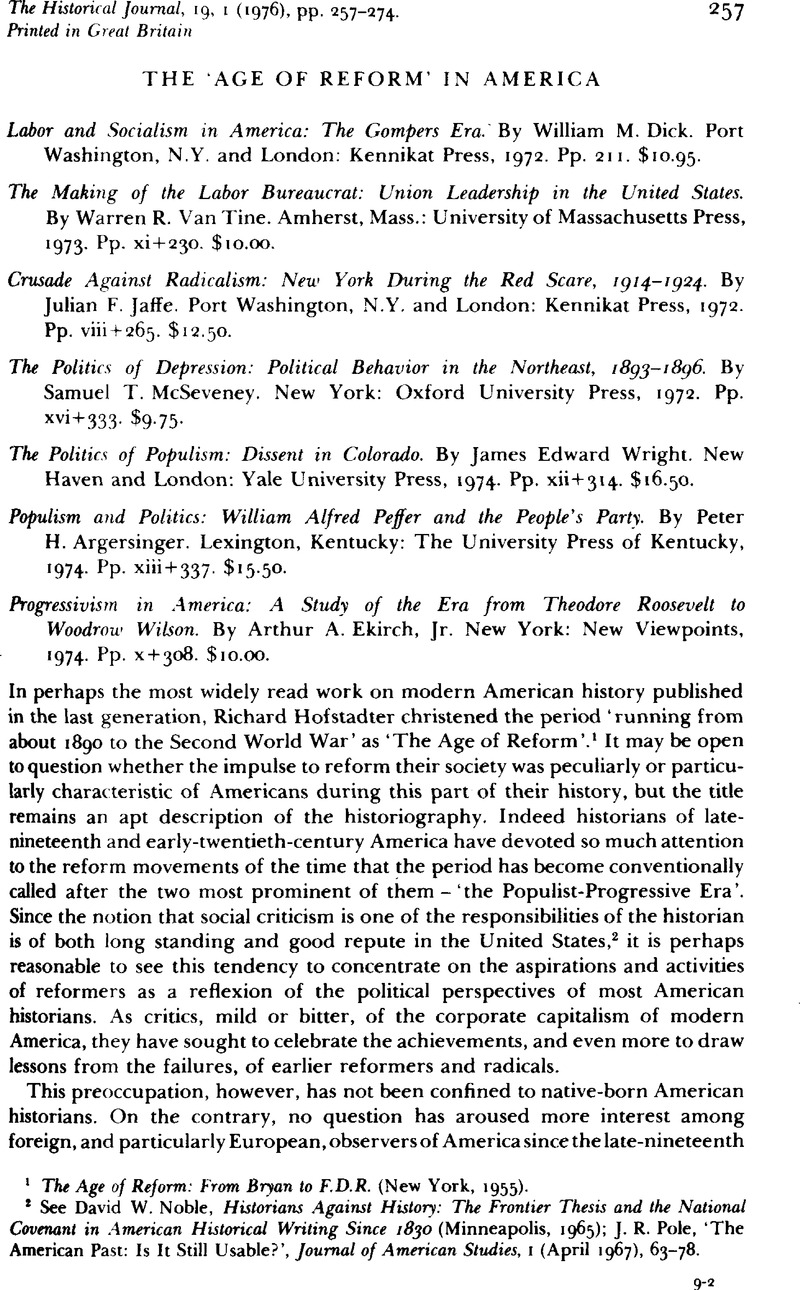Article contents
The ‘Age of Reform’ in America
Published online by Cambridge University Press: 11 February 2009
Abstract

- Type
- Review Articles
- Information
- Copyright
- Copyright © Cambridge University Press 1976
References
1 The Age of Reform: From Bryan to F.D.R., (New York, 1955).Google Scholar
2 See Noble, David W.Historians Against History: The Frontier Thesis and the National Covenant in American Historical Writing Since 1830 (Minneapolis, 1965);Google ScholarPole, J. R., ‘The American Past: Is It Still Usable?’, Journal of American Studies, 1 (April 1967), 63–78.Google Scholar
3 John, H. M., Laslett and Seymour Martin Lipset (eds), Failure of a Dream? Essays in the History of American Socialism (New York, 1974).Google Scholar
4 Labor and the Left: A Study of Socialist and Radical Influences in the American Labor Movement, 1881–1924 (New York, 1970),Google Scholar
5 The Liberal Tradition in America: An Interpretation of American Political Thought Sinct the Revolution (New York, 1955), p. 4.Google Scholar
6 ‘A View From The Farther Shore’, Comparative Studies in Society and History, v (1962–3),269.
7 Perlman, SeligA Theory of the Labor Movement (New York, 1928), p. 197.Google Scholar
8 Ibid., p. 198.
9 Beyond Equality: Labor and the Radical Republicans (New York, 1967), p. 206.Google Scholar
10 Ibid., P 199.
11 See, for example, Thernstrom, Stephan, Poverty and Progress: Social Mobility in a Nineteenth Century City (Cambridge, Mass., 1964),Google Scholar and The Other Bostonians: Poverty and Progress in the American Metropolis, 1880–1970 (Cambridge, Mass., 1973); Gutman, Herbert G. ‘Work, Culture, and Society in Industrializing America, 1815–1919’, American Historical Review, LXXVIII (06 1973), 531–87.Google Scholar
12 ‘Career Leadership and American Trade Unionism’ in Jaher, Frederic C. (ed.), The Age of Industrialism in America; Essays in Social Structure and Cultural Values (New York and London, 1968), pp. 288–303.Google Scholar
13 Murray, Robert K.Red Scare: A Study in National Hysteria, 1919–1920 (Minneapolis, 1955), PP. 190–1;Google Scholar Stanley Coben, Mitchell, A.Palmer: Politician (New York and London, 1963), pp. 213–16, 244–5, 265–6.Google Scholar
14 See Higham, JohnStrangers in the Land: Patterns of American Nativism, 1860–1925 (rev.edn, New York, 1963),Google Scholar chapters 8 and 9; Coben, Stanley, ‘A Study in Nativism: The American Red Scare of 1919–1920’, Political Science Quarterly, LXXIX (Mar. 1964), pp. 55–75.Google Scholar
15 The most prominent pioneer both of the application of statistical techniques to tht analysis of nineteenth-century elections, and of the emphasis on the importance of ‘ethnocultural’ groups, was, of course, Benson., Lee See, particularly, The Concept Jacksonian Democracy: New York as a Test Case(Princeton, N.J., 1961). For an up-to-date guide to this literature, see Robert P. Swierenga, ‘Computers and American History: The Impact of the “New” Generation’, Journal of American History, LX (Mar. 1974), p. 1054.Google Scholar
16 Kleppner, Paul, The Cross of Culture: A Social Analysis of Midwestern Politics, 1850–1900 (New York, 1970), especially chapters 1–2; Richard Jensen, The Winning of the Midwest: Socia and Political Conflict, 1888–1896 (Chicago and London, 1971), esp. pp. xiii, 58–87, 309–15.Google Scholar
17 According to Jensen, , high-church Episcopalians (a small, elite group) were also generally Democratic (Jensen, op. cit., pp. 78–9).Google Scholar
18 Kleppner, op. cit., chapter 4; Jensen op. cit., chapters 4–5.Google Scholar
19 Kleppner, op. cit., pp. 7, 91, 143–78, 370–1.Google Scholar
20 Kleppner, op. cit., chapter 8, Jensen op. cit., pp. 278–9, 284–6, 291–306.Google Scholar
21 McSeveney pp. 182–3; Jensen, , op. cit., pp. 292–5.Google Scholar
22 McSeveney pp. 181–2; Jensen, , op. cit., p. 284.Google Scholar
23 Jensen, op. cit., pp. 59, 61, 315Google Scholar; Kleppner op. cit., pp. 64–5, 105–6.
24 Jensen, op. cit., p. 88.Google Scholar
25 In the Northeast, too, the Democrats retained the loyalty of large numbers of Protestants. See McSeveney, p. 13.
26 Jensen op. cit., pp. 309–15.
27 See, particularly, Pollack, NormanThe Populist Response to Industrial America: Mid-western Populist Thought (Cambridge, Mass., 1962);Google Scholar Walter Nugent, T. K.. The Tolerant Populists: Kansas Populism and Nativism (Chicago, 1963)Google Scholar
28 Hackney, SheldonPopulism to Progressivism in Alabama ( Princeton, N.J..1969).Google Scholar
30 Hackney, Populism to Progressivism in Albama, pp. 71–5;Google ScholarBricha, Karel D. ‘A Further Reconsideration of American Populism’, Mid-America, LHI (Jan. 1971), pp. 5–7.Google Scholar
29 Incidentally, both Argersinger and Wright suggest that many of these farmers grew corn rather than wheat, which qualifies the conclusions of previous studies of Populism on the Great Plains. (See Parsons, Stanley B., ‘Who Were the Nebraska Populists?’, Nebraska History, 44 (06 1963), pp. 97–9;Google ScholarRogin, Michael P., The Intellectuals and McCarthy: The Radical Specter (Cambridge, Mass., 1967), pp. 140–2,Google Scholar 188.) This qualification does not, however, undermine Benton Wilcox's original, classic analysis of the relationship between agrarian radicalism and types of agriculture. The basic distinction Wilcox made was between dairy farming and ‘corn-live stock farming’ on the one hand, and ‘grain farming, predominantly wheat’ on the other. See Benton Wilcox, ‘An Historical Definition of Northwestern Radicalism’, Mississippi Valley Historical Review, XXVI (12. 1939), pp. 383Google Scholar
30 Hackney, , Populism to Progressivism in Albama, pp. 71–5;Google ScholarBricha, Karel D., ‘A Further Reconsideration of American Populism’, Mid-America, LHI (01. 1971), pp. 5–7.Google Scholar
31 For example, Graham., OtisL. Jr An Encore for Reform: The Old Progressives and the New Dea/(New York, 1967);Google ScholarWeinstein, JamesThe Corporate Ideal in the Liberal State (Boston,1968).Google Scholar
32 Graham, Otis L., Jr., The Great Campaigns: Reform and War in America, 1900–1928 (Englewood Cliffs, N.J., 1971).Google Scholar
33 For an attempt to analyse this relationship, see my own article, ‘American Progressiveo Publicists and the First World War, 1914–1917’, Journal of American History, LVIII (09, 1971), pp. 364–83.Google Scholar
34 Wiebe, Robert H.Businessmen and Reform: A Study of the Progressive Movement (Cambridge Mass., 1962).Google Scholar
- 2
- Cited by


